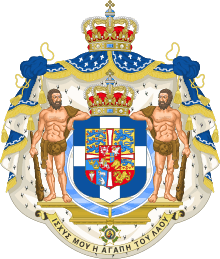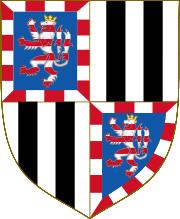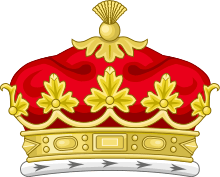Prince Philip, Duke of Edinburgh
Prince Philip, Duke of Edinburgh (born Prince Philip of Greece and Denmark,[1] 10 June 1921),[fn 1] is the husband of Queen Elizabeth II of the United Kingdom and other Commonwealth realms.
| Prince Philip | |
|---|---|
| Duke of Edinburgh (more) | |
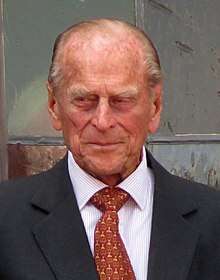 Philip in 2015 | |
| Consort of the British monarch | |
| Tenure | 6 February 1952 – present |
| Born | Prince Philip of Greece and Denmark 10 June 1921 Mon Repos, Corfu, Kingdom of Greece |
| Spouse | Queen Elizabeth II ( m. 1947) |
| Issue Detail | |
| House |
|
| Father | Prince Andrew of Greece and Denmark |
| Mother | Princess Alice of Battenberg |
| Signature |  |
| Military career | |
| Allegiance | |
| Service/ | |
| Years of service | 1939–1952 (active service) |
| Rank | Admiral of the Fleet Field Marshal Marshal of the Royal Air Force |
| Commands held | HMS Magpie |
| Battles/wars | Second World War |
| Awards |
|
| Royal family of the United Kingdom and the other Commonwealth realms |
|---|
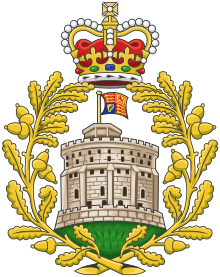 |
|
Philip was born into the Greek and Danish royal families. He was born in Greece, but his family was exiled from the country when he was an infant. After being educated in France, Germany, and the United Kingdom, he joined the British Royal Navy in 1939, aged 18. From July 1939, he began corresponding with the 13-year-old Princess Elizabeth, whom he had first met in 1934. During the Second World War he served with distinction in the Mediterranean and Pacific Fleets. After the war, Philip was granted permission by George VI to marry Elizabeth. Before the official announcement of their engagement in July 1947, he abandoned his Greek and Danish royal titles, became a naturalised British subject, and adopted his maternal grandparents' surname Mountbatten. He married Elizabeth on 20 November 1947. Just before the wedding, he was created Duke of Edinburgh, Earl of Merioneth and Baron Greenwich. Philip left active military service when Elizabeth became queen in 1952, having reached the rank of commander, and was formally made a British prince in 1957.
Philip and Elizabeth have four children: Prince Charles, Princess Anne, Prince Andrew, and Prince Edward. Through a British Order in Council issued in 1960, descendants of the couple not bearing royal styles and titles can use the surname Mountbatten-Windsor, which has also been used by some members of the royal family who do hold titles, such as Princess Anne, and Princes Andrew and Edward.
A keen sports enthusiast, Philip helped develop the equestrian event of carriage driving. He is a patron, president, or member of over 780 organisations, and he serves as chairman of The Duke of Edinburgh's Award, a self improvement program for young people aged 14 to 24.[2] He is the longest-serving consort of a reigning British monarch and the oldest ever male member of the British royal family. Philip retired from his royal duties on 2 August 2017, aged 96, having completed 22,219 solo engagements since 1952.
Early life
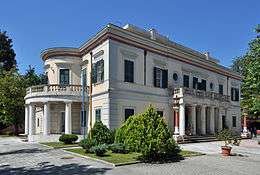
Prince Philip of Greece and Denmark was born in Mon Repos on the Greek island of Corfu on 10 June 1921, the only son and fifth and final child of Prince Andrew of Greece and Denmark and Princess Alice of Battenberg.[3] A member of the House of Glücksburg, the ruling house of Denmark, he was a prince of both Greece and Denmark by virtue of his patrilineal descent from George I of Greece and Christian IX of Denmark, and he was from birth in the line of succession to both thrones.[fn 2] Philip's four elder sisters were Margarita, Theodora, Cecilie, and Sophie. He was baptised in the Greek Orthodox rite at St. George's Church in the Old Fortress in Corfu.
Shortly after Philip's birth, his maternal grandfather, Prince Louis of Battenberg, then known as Louis Mountbatten, Marquess of Milford Haven, died in London. Louis was a naturalised British subject, who, after a career in the Royal Navy, had renounced his German titles and adopted the surname Mountbatten—an Anglicised version of Battenberg—during the First World War, owing to anti-German sentiment in Britain. After visiting London for his grandfather's memorial service, Philip and his mother returned to Greece, where Prince Andrew had remained behind to command an army division embroiled in the Greco-Turkish War.[5]
The war went badly for Greece, and the Turks made large gains. On 22 September 1922, Philip's uncle, King Constantine I, was forced to abdicate, and the new military government arrested Prince Andrew, along with others. The commander of the army, General Georgios Hatzianestis, and five senior politicians were executed. Prince Andrew's life was believed to be in danger, and Alice was under surveillance. In December, a revolutionary court banished Prince Andrew from Greece for life.[6] The British naval vessel HMS Calypso evacuated Prince Andrew's family, with Philip carried to safety in a cot made from a fruit box. Philip's family went to France, where they settled in the Paris suburb of Saint-Cloud in a house lent to them by his wealthy aunt, Princess George of Greece and Denmark.[7]
Because Philip left Greece as a baby, he does not speak Greek. In 1992, he said that he "could understand a certain amount".[8] Philip has stated that he thought of himself as Danish, and his family spoke English, French, and German.[8] Philip, who in his youth was known for his charm, was linked to a number of women, including Osla Benning.[9]
Youth
Education
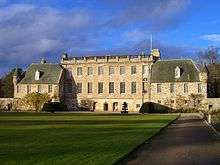
Philip was first educated at The Elms,[10] an American school in Paris run by Donald MacJannet, who described Philip as a "know it all smarty person, but always remarkably polite".[11] In 1928, he was sent to the United Kingdom to attend Cheam School, living with his maternal grandmother, Victoria Mountbatten, Dowager Marchioness of Milford Haven, at Kensington Palace and his uncle, George Mountbatten, 2nd Marquess of Milford Haven, at Lynden Manor in Bray, Berkshire.[12] In the next three years, his four sisters married German princes and moved to Germany, his mother was diagnosed with schizophrenia and placed in an asylum,[13] and his father took up residence in Monte Carlo.[14] Philip had little contact with his mother for the remainder of his childhood.[15] In 1933, he was sent to Schule Schloss Salem in Germany, which had the "advantage of saving school fees" because it was owned by the family of his brother-in-law, Berthold, Margrave of Baden.[16] With the rise of Nazism in Germany, Salem's Jewish founder, Kurt Hahn, fled persecution and founded Gordonstoun School in Scotland, to which Philip moved after two terms at Salem.[17] In 1937, his sister Cecilie, her husband Georg Donatus, Hereditary Grand Duke of Hesse, her two young sons, Ludwig and Alexander, her newborn infant, and her mother-in-law, Princess Eleonore of Solms-Hohensolms-Lich, were killed in an air crash at Ostend; Philip, then 16 years old, attended the funeral in Darmstadt.[18] The following year, his uncle and guardian Lord Milford Haven died of bone marrow cancer.[19]
Naval and wartime service
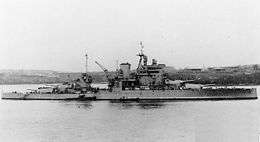
After leaving Gordonstoun in early 1939, Philip completed a term as a cadet at the Royal Naval College, Dartmouth, then repatriated to Greece, living with his mother in Athens for a month in mid-1939. At the behest of the Greek king, George II, he returned to Britain in September to resume training for the Royal Navy.[20] He graduated from Dartmouth the next year as the best cadet in his course.[21] During the Second World War, he continued to serve in the British forces, while two of his brothers-in-law, Prince Christoph of Hesse and Berthold, Margrave of Baden, fought on the opposing German side.[22] Philip was appointed as a midshipman in January 1940. He spent four months on the battleship HMS Ramillies, protecting convoys of the Australian Expeditionary Force in the Indian Ocean, followed by shorter postings on HMS Kent, on HMS Shropshire, and in Ceylon.[23] After the invasion of Greece by Italy in October 1940, he was transferred from the Indian Ocean to the battleship HMS Valiant in the Mediterranean Fleet.[24]
On 1 February 1941,[25] Philip was commissioned as a sub-lieutenant after a series of courses at Portsmouth, in which he gained the top grade in four out of five sections of the qualifying examination.[26] Among other engagements, he was involved in the battle of Crete, and was mentioned in dispatches for his service during the battle of Cape Matapan,[10] in which he controlled the battleship's searchlights. He was also awarded the Greek War Cross.[21] In June 1942, he was appointed to the V and W-class destroyer and flotilla leader HMS Wallace, which was involved in convoy escort tasks on the east coast of Britain, as well as the Allied invasion of Sicily.[27]
Promotion to lieutenant followed on 16 July 1942.[28] In October of the same year, he became first lieutenant of HMS Wallace, at 21 years old one of the youngest first lieutenants in the Royal Navy. During the invasion of Sicily, in July 1943, as second in command of Wallace, he saved his ship from a night bomber attack. He devised a plan to launch a raft with smoke floats that successfully distracted the bombers, allowing the ship to slip away unnoticed.[27] In 1944, he moved on to the new destroyer, HMS Whelp, where he saw service with the British Pacific Fleet in the 27th Destroyer Flotilla.[29][30] He was present in Tokyo Bay when the instrument of Japanese surrender was signed. Philip returned to the United Kingdom on the Whelp in January 1946, and was posted as an instructor at HMS Royal Arthur, the Petty Officers' School in Corsham, Wiltshire.[31]
Marriage
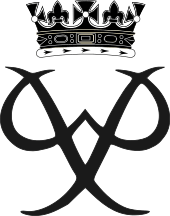
In 1939, King George VI and Queen Elizabeth toured the Royal Naval College, Dartmouth. During the visit, the Queen and Louis Mountbatten asked Philip to escort the King's two daughters, Elizabeth and Margaret, who were Philip's third cousins through Queen Victoria, and second cousins once removed through King Christian IX of Denmark.[32] Elizabeth fell in love with Philip, and they began to exchange letters when she was 13.[33]
Eventually, in the summer of 1946, Philip asked the King for his daughter's hand in marriage. The King granted his request, provided that any formal engagement be delayed until Elizabeth's 21st birthday the following April.[34] By March 1947, Philip had abandoned his Greek and Danish royal titles, had adopted the surname Mountbatten from his mother's family, and had become a naturalised British subject. The engagement was announced to the public on 10 July 1947.[35]
Though Philip appeared "always to have regarded himself as an Anglican",[36] and he had attended Anglican services with his classmates and relations in England and throughout his Royal Navy days, he had been baptised in the Greek Orthodox Church. The Archbishop of Canterbury, Geoffrey Fisher, wanted to "regularise" Philip's position by officially receiving him into the Church of England,[37] which he did in October 1947.[38]
The day before the wedding, King George VI bestowed the style of Royal Highness on Philip and, on the morning of the wedding, 20 November 1947, he was made the Duke of Edinburgh, Earl of Merioneth, and Baron Greenwich of Greenwich in the County of London.[39] Consequently, being already a Knight of the Garter, between 19 and 20 November 1947 he bore the unusual style His Royal Highness Sir Philip Mountbatten, and is so described in the Letters Patent of 20 November 1947.[39]
Philip and Elizabeth were married in a ceremony at Westminster Abbey, recorded and broadcast by BBC radio to 200 million people around the world.[40] In post-war Britain it was not acceptable for any of the Duke of Edinburgh's German relations to be invited to the wedding, including Philip's three surviving sisters, all of whom had married German princes. After their marriage, the Duke and Duchess of Edinburgh took up residence at Clarence House. Their first two children were born before Elizabeth succeeded her father as monarch in 1952: Prince Charles in 1948 and Princess Anne in 1950. Their marriage is now the longest of any British monarch.[41][42]
Philip was introduced to the House of Lords on 21 July 1948,[43] immediately before his uncle Louis Mountbatten, who had been made Earl Mountbatten of Burma.[44] Philip, like his sons Charles and Andrew and other royals (with the exception of the 1st Earl of Snowdon), ceased to be members of the House of Lords following the House of Lords Act 1999. He never spoke in the House.
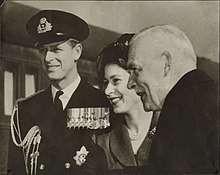
After his honeymoon at the Mountbatten family home, Broadlands, Philip returned to the navy at first in a desk job at the Admiralty, and later on a staff course at the Naval Staff College, Greenwich.[45] From 1949, he was stationed in Malta (residing at Villa Guardamangia) after being posted as the first lieutenant of the destroyer HMS Chequers, the lead ship of the 1st Destroyer Flotilla in the Mediterranean Fleet.[46] On 16 July 1950, he was promoted to lieutenant commander and given command of the frigate HMS Magpie.[47][48] On 30 June 1952, Philip was promoted to commander,[49] though his active naval career had ended in July 1951.[50][51]
With the King in ill health, Princess Elizabeth and the Duke of Edinburgh were both appointed to the Privy Council on 4 November 1951, after a coast-to-coast tour of Canada. At the end of January 1952, Philip and his wife set out on a tour of the Commonwealth. On 6 February 1952, they were in Kenya when Elizabeth's father died and she became queen. It was Philip who broke the news to Elizabeth at Sagana Lodge, and the royal party immediately returned to the United Kingdom.[52]
Consort of the Queen
Royal house
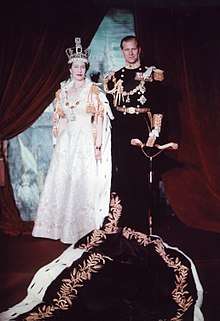
The accession of Elizabeth to the throne brought up the question of the name of the royal house, as Elizabeth would typically have taken Philip's last name upon marriage. The Duke's uncle, Earl Mountbatten of Burma, advocated the name House of Mountbatten. Philip suggested House of Edinburgh, after his ducal title.[53] When Queen Mary, Elizabeth's grandmother, heard of this, she informed the British prime minister, Winston Churchill, who himself later advised the Queen to issue a royal proclamation declaring that the royal house was to remain known as the House of Windsor. Prince Philip privately complained, "I am nothing but a bloody amoeba. I am the only man in the country not allowed to give his name to his own children."[54]
On 8 February 1960, several years after the death of Queen Mary and the resignation of Churchill as prime minister, the Queen issued an Order in Council declaring that Mountbatten-Windsor would be the surname of her and her husband's male-line descendants who are not styled as Royal Highness or titled as prince or princess.[55] While it seems the Queen had "absolutely set her heart" on such a change and had it in mind for some time, it occurred only 11 days before the birth of Prince Andrew (19 February), and only after three months of protracted correspondence between constitutional expert Edward Iwi (who averred that, without such a change, the royal child would be born with "the Badge of Bastardy") and Prime Minister Harold Macmillan who had attempted to rebuff Iwi.[56]
After her accession to the throne, the Queen also announced that the Duke was to have "place, pre-eminence and precedence" next to her "on all occasions and in all meetings, except where otherwise provided by Act of Parliament". This meant the Duke took precedence over his son, the Prince of Wales, except, officially, in the British parliament. In fact, however, he attends Parliament only when escorting the Queen for the annual State Opening of Parliament, where he walks and sits beside her.[57] Contrary to rumours over the years, the Queen and Duke are said by insiders to have had a strong relationship throughout their marriage, despite the challenges of Elizabeth's reign.[58][59] The Queen referred to Prince Philip in a speech on the occasion of her Diamond Jubilee in 2012 as her "constant strength and guide".[59]
Prince Philip receives a Parliamentary annuity (of £359,000 since 1990[fn 3]) that serves to meet official expenses in carrying out public duties. The annuity is unaffected by the reform of royal finances under the Sovereign Grant Act 2011.[60][61] Any part of the allowance that is not used to meet official expenditure is liable for tax. In practice, the entire allowance is used to fund his official duties.[62]
Duties and milestones
_(17843185594).jpg)
As consort to the Queen, Philip supported his wife in her new duties as sovereign, accompanying her to ceremonies such as the State Opening of Parliament in various countries, state dinners, and tours abroad. As chairman of the Coronation Commission, he was the first member of the royal family to fly in a helicopter, visiting the troops that were to take part in the ceremony.[63] Philip was not crowned in the service, but knelt before Elizabeth, with her hands enclosing his, and swore to be her "liege man of life and limb".[64]
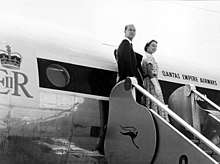
In the early 1950s, his sister-in-law, Princess Margaret, considered marrying a divorced older man, Peter Townsend. The press accused Philip of being hostile to the match, to which he replied "I haven't done anything." Philip had not interfered, preferring to stay out of other people's love lives.[65] Eventually, Margaret and Townsend parted. For six months, over 1953–54, Philip and Elizabeth toured the Commonwealth; as with previous tours the children were left in Britain.[66]
In 1956, the Duke, with Kurt Hahn, founded The Duke of Edinburgh's Award in order to give young people "a sense of responsibility to themselves and their communities". In the same year, he also established the Commonwealth Study Conferences. From 1956 to 1957, Philip travelled around the world aboard the newly commissioned HMY Britannia, during which he opened the 1956 Summer Olympics in Melbourne and visited the Antarctic, becoming the first royal to cross the Antarctic Circle.[67] The Queen and the children remained in the UK. On the return leg of the journey, Philip's private secretary, Mike Parker, was sued for divorce by his wife. As with Townsend, the press still portrayed divorce as a scandal and eventually Parker resigned. He later said that the Duke was very supportive and "the Queen was wonderful throughout. She regarded divorce as a sadness, not a hanging offence."[68] In a public show of support, the Queen created Parker a Commander of the Royal Victorian Order.[69]
Further press reports claimed that the Queen and the Duke were drifting apart, which enraged the Duke and dismayed the Queen, who issued a strongly worded denial.[70] On 22 February 1957, she granted her husband the style and title of a Prince of the United Kingdom by Letters Patent, and it was gazetted that he was to be known as "His Royal Highness The Prince Philip, Duke of Edinburgh".[71] Philip was appointed to the Queen's Privy Council for Canada on 14 October 1957, taking his Oath of Allegiance before the Queen in person at her Canadian residence, Rideau Hall.[72] Remarks he made two years later to the Canadian Medical Association on the subject of youth and sport were taken as a suggestion that Canadian children were out of shape. This was at first considered "tactless", but Philip was later admired for his encouragement of physical fitness.[73] In Canada in 1969, Philip spoke about his views on republicanism:
It is a complete misconception to imagine that the monarchy exists in the interests of the monarch. It doesn't. It exists in the interests of the people. If at any time any nation decides that the system is unacceptable, then it is up to them to change it.[74]
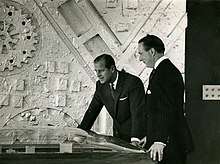
Philip is patron of some 800 organisations, particularly focused on the environment, industry, sport, and education. His first solo engagement as Duke of Edinburgh was in March 1948, presenting prizes at the boxing finals of the London Federation of Boys' Clubs at the Royal Albert Hall.[75] He was president of the National Playing Fields Association (now known as Fields in Trust) for 64 years, from 1947 until his grandson Prince William took over the role in 2013.[76] He served as UK president of the World Wildlife Fund from 1961 to 1982, international president from 1981, and president emeritus from 1996.[67] In 1952, he became patron of The Industrial Society (since renamed The Work Foundation).[10] He was president of the International Equestrian Federation from 1964 to 1986,[77] and has served as chancellor of the universities of Cambridge, Edinburgh, Salford, and Wales.[78] In 2017, the British Heart Foundation thanked Prince Philip for being its patron for 55 years, during which time, in addition to organising fundraisers, he "supported the creation of nine BHF-funded centres of excellence".[79] He is an Honorary Fellow of St Edmund's College, Cambridge.[80]
Charles and Diana

At the beginning of 1981, Philip wrote to his eldest son, Charles, counselling him to make up his mind to either propose to Lady Diana Spencer or break off their courtship.[81] Charles felt pressured by his father to make a decision and did so, proposing to Diana in February.[82] They married five months later. By 1992, the marriage of the Prince and Princess of Wales had broken down. The Queen and Philip hosted a meeting between Charles and Diana, trying to effect a reconciliation, but without success.[83] Philip wrote to Diana, expressing his disappointment at both Charles's and her extra-marital affairs, and asking her to examine both his and her behaviour from the other's point of view.[84] She found the letters hard to take, but nevertheless appreciated that he was acting with good intent.[85] Charles and Diana separated and later divorced.
A year after the divorce, Diana was killed in a car crash in Paris on 31 August 1997. At the time, the Duke was on holiday at Balmoral with the extended royal family. In their grief, Diana's two sons, Princes William and Harry, wanted to attend church and so their grandparents took them that morning.[86] For five days, the Queen and the Duke shielded their grandsons from the ensuing press interest by keeping them at Balmoral, where they could grieve in private.[86] The royal family's seclusion caused public dismay,[86] but the public mood changed after a live broadcast made by the Queen on 5 September.[87] Uncertain as to whether they should walk behind her coffin during the funeral procession, Diana's sons hesitated.[87] Philip told William, "If you don't walk, I think you'll regret it later. If I walk, will you walk with me?"[87] On the day of the funeral, Philip, William, Harry, Charles, and Diana's brother, Earl Spencer, walked through London behind her bier.
Over the next few years, Mohamed Fayed, whose son Dodi Fayed was also killed in the crash, claimed that Prince Philip had ordered the death of Diana and that the accident was staged. The inquest into the Princess of Wales's death concluded in 2008 that there was no evidence of a conspiracy.[88]
21st century
During his wife's Golden Jubilee in 2002, the Duke was commended by the Speaker of the British House of Commons for his role in supporting the Queen during her reign. The Duke of Edinburgh's time as royal consort exceeds that of any other consort in British history;[89] however, Queen Elizabeth The Queen Mother (his mother-in-law), who died aged 101, has had the longest lifespan to date. Philip is also the oldest ever male member of the British royal family, and the third longest-lived following Princess Alice, Duchess of Gloucester, and Queen Elizabeth The Queen Mother.[90]
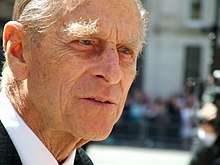
In April 2008, Philip was admitted to King Edward VII's Hospital, London, for "assessment and treatment" for a chest infection, though he walked into the hospital unaided and recovered quickly,[91] and was discharged three days later to recuperate at Windsor Castle.[92] In August, the Evening Standard reported that he was suffering from prostate cancer. Buckingham Palace, which usually refuses to comment on rumours of ill health, claimed that the report was an invasion of privacy and issued a statement denying the story.[93] The newspaper retracted the report and admitted it was untrue.[94][95]
In June 2011, in an interview marking his 90th birthday he said that he would now slow down and reduce his duties, stating that he had "done [his] bit".[96] His wife, the Queen, gave him the title Lord High Admiral for his 90th birthday.[97] While staying at Sandringham House, the royal residence in Norfolk, on 23 December 2011, the Duke suffered chest pains and was taken to the cardio-thoracic unit at Papworth Hospital, Cambridgeshire, where he underwent successful coronary angioplasty and stenting.[98] He was discharged on 27 December.[99]
On 4 June 2012, during the celebrations in honour of his wife's Diamond Jubilee, Philip was taken from Windsor Castle to King Edward VII's Hospital suffering from a bladder infection.[100][101] He was released from hospital on 9 June.[102] After a recurrence of infection in August 2012, while staying at Balmoral Castle, he was admitted to Aberdeen Royal Infirmary for five nights as a precautionary measure.[103] In June 2013, Philip was admitted to the London Clinic for an exploratory operation on his abdomen, spending 11 days in hospital.[104] On 21 May 2014, the Prince appeared in public with a bandage on his right hand after a "minor procedure" was performed in Buckingham Palace the preceding day.[105] In June 2017, he was taken from Windsor to London and admitted to King Edward VII's Hospital after being diagnosed with an infection.[106] He spent two nights in the hospital and was unable to attend the State Opening of Parliament and Royal Ascot.[107][108]
Retirement (2017–present)
Prince Philip retired from his royal duties on 2 August 2017, meeting Royal Marines in his final solo public engagement, aged 96. Since 1952 he had completed 22,219 solo engagements. Prime Minister Theresa May thanked him for "a remarkable lifetime of service".[109][110] On 20 November 2017, he celebrated his 70th wedding anniversary with the Queen, which made her the first British monarch to celebrate a platinum wedding anniversary.[111]
On 3 April 2018, Philip was admitted to King Edward VII's Hospital for a planned hip replacement, which took place the next day. This came after the Duke missed the annual Maundy and Easter Sunday services. On 12 April his daughter, Princess Anne, spent about 50 minutes in the hospital and afterwards said her father was "on good form". He was discharged the following day.[112] On 19 May, six weeks later, he attended the wedding of his grandson Prince Harry to Meghan Markle and was able to walk with the Queen unaided.[113] That October, he accompanied the Queen to the wedding of their granddaughter Princess Eugenie to Jack Brooksbank,[114] with The Daily Telegraph reporting that Philip works on a "wake up and see how I feel" basis when deciding whether to attend an event or not.[115]
On 17 January 2019, 97-year-old Philip was involved in a car crash as he pulled out onto a main road near the Sandringham Estate. An official statement said he was uninjured. An eyewitness who came to the prince's aid described having to wipe blood off his hands.[116] The driver and a passenger of the other car were injured and taken to hospital.[117] Philip attended hospital the next morning as a precaution.[118] He apologised,[119] and three weeks later voluntarily surrendered his driving licence.[120][121] On 14 February the Crown Prosecution Service announced that prosecuting Philip would not be in the public interest.[122] The Duke is still allowed to drive around private estates, and was seen behind the wheel in the grounds of Windsor Castle in April 2019.[123]
From 20 to 24 December 2019, Philip stayed at King Edward VII's Hospital and received treatment for a "pre-existing condition", in a visit described by Buckingham Palace as a "precautionary measure".[124] He had not been seen in public since attending Lady Gabriella Kingston's wedding in May 2019.[125] A photo of Philip with the Queen as they isolated at Windsor Castle during the COVID-19 pandemic was released ahead of his 99th birthday in June 2020.[126]
Personality and image
.jpg)
Philip played polo until 1971, when he started to compete in carriage driving, a sport which he helped to expand; the early rule book was drafted under his supervision.[127] He was also a keen yachtsman and struck up a friendship in 1949 with Uffa Fox, in Cowes. Philip and the Queen regularly attended Cowes Week in HMY Britannia. His first airborne flying lesson took place in 1952; by his 70th birthday he had accrued 5,150 pilot hours.[128] He was presented with Royal Air Force wings in 1953.[129] In April 2014, it was reported that an old British Pathe newsreel film had been discovered of Philip's 1962 two-month flying tour of South America. Filmed sitting alongside Philip at the aircraft's controls was his co-pilot Captain Peter Middleton, the grandfather of the Duke's granddaughter-in-law, Catherine, Duchess of Cambridge.[130][131]
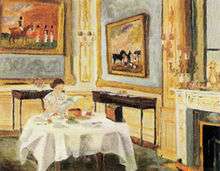
He has painted with oils, and collected artworks, including contemporary cartoons, which hang at Buckingham Palace, Windsor Castle, Sandringham House, and Balmoral Castle. Hugh Casson described Philip's own artwork as "exactly what you'd expect ... totally direct, no hanging about. Strong colours, vigorous brushstrokes."[133]
Philip's down-to-earth manner was attested to by a White House butler who recalled that, on a visit in 1979, Philip had engaged him and a fellow butler in a conversation and poured them drinks.[134] As well as a reputation for bluntness and plain speaking,[135] Philip is noted for occasionally making observations and jokes that have been construed as either funny, or as gaffes: awkward, politically incorrect, or even offensive, but sometimes perceived as stereotypical of someone of his age and background.[136][137][138][139][140] In an address to the General Dental Council in 1960, he jokingly coined a new word for his blunders: "Dontopedalogy is the science of opening your mouth and putting your foot in it, a science which I have practised for a good many years."[141] Later in life he suggested his comments may have contributed to the perception that he is "a cantankerous old sod".[142]
The historian David Starkey described him as a kind of "HRH Victor Meldrew".[143] For example, in May 1999, British newspapers accused Philip of insulting deaf children at a pop concert in Wales by saying, "No wonder you are deaf listening to this row."[144] Later Philip wrote, "The story is largely invention. It so happens that my mother was quite seriously deaf and I have been Patron of the Royal National Institute for the Deaf for ages, so it's hardly likely that I would do any such thing."[145] When he and the Queen met Stephen Menary, an army cadet blinded by an IRA bomb, and the Queen enquired how much sight he retained, Philip quipped: "Not a lot, judging by the tie he's wearing." Menary later said: "I think he just tries to put people at ease by trying to make a joke. I certainly didn't take any offence."[146]
During a state visit to China in 1986, in a private conversation with British students from Xi'an's North West University, Philip joked, "If you stay here much longer, you'll go slit-eyed."[147] The British press reported on the remark as indicative of racial intolerance, but the Chinese authorities were reportedly unconcerned. Chinese students studying in the UK, an official explained, were often told in jest not to stay away too long, lest they go "round-eyed".[148] His comment had no effect on Sino-British relations, but it shaped his own reputation.[149]
Portrayals
Philip has been portrayed by several actors including Stewart Granger (The Royal Romance of Charles and Diana, 1982), Christopher Lee (Charles & Diana: A Royal Love Story, 1982), David Threlfall (The Queen's Sister, 2005), James Cromwell (The Queen, 2006), and Matt Smith, Finn Elliot and Tobias Menzies (The Crown, 2016 onwards).[150]
Prince Philip appears as a fictional character in Nevil Shute's novel In the Wet (1952), Paul Gallico's novel Mrs. 'Arris Goes to Moscow (1974), Tom Clancy's novel Patriot Games (1987), and Sue Townsend's novel The Queen and I (1992).[151]
Books
The prince has authored a number of books:
- Selected Speeches – 1948–55 (1957, revised paperback edition published by Nabu Press in 2011) ISBN 978-1245671330
- Selected Speeches – 1956–59 (1960)
- Birds from Britannia (1962) (published in the United States as Seabirds from Southern Waters) ISBN 978-1163699294
- Wildlife Crisis with James Fisher (1970) ISBN 978-0402125112
- The Environmental Revolution: Speeches on Conservation, 1962–1977 (1978) ISBN 978-0846414537
- Competition Carriage Driving (1982) (published in France 1984, second edition 1984, revised edition 1994) ISBN 978-0851315942
- A Question of Balance (1982) ISBN 978-0859550871
- Men, Machines and Sacred Cows (1984) ISBN 978-0241111741
- A Windsor Correspondence with Michael Mann (1984) ISBN 978-0859551083
- Down to Earth: Collected Writings and Speeches on Man and the Natural World 1961–87 (1988) (paperback edition 1989, Japanese edition 1992) ISBN 978-0828907118
- Survival or Extinction: A Christian Attitude to the Environment with Michael Mann (1989) ISBN 978-0859551588
- Driving and Judging Dressage (1996) ISBN 978-0851316666
- 30 Years On, and Off, the Box Seat (2004) ISBN 978-0851318981
Forewords to:
- Royal Australian Navy 1911–1961 Jubilee Souvenir issued by authority of the Department of the Navy, Canberra (1961)
- The Concise British Flora in Colour by William Keble Martin, Ebury Press/ Michael Joseph (1965)
- Kurt Hahn by Hermann Röhrs and Hilary Tunstall-Behrens (1970)
- The Art of Driving by Max Pape (1982) ISBN 978-0851313399
- Yachting and the Royal Prince Alfred Yacht Club by Graeme Norman (1988) ISBN 978-0867770674
- National Maritime Museum Guide to Maritime Britain by Keith Wheatley, (2000)
- The Royal Yacht Britannia: The Official History by Richard Johnstone-Bryden, Conway Maritime Press (2003) ISBN 978-0851779379
- 1953: The Crowning Year of Sport by Jonathan Rice, (2003)
- British Flags and Emblems by Graham Bartram, Tuckwell Press (2004) ISBN 978-1862322974
- Chariots of War by Robert Hobson, Ulric Publication (2004) ISBN 978-0954199715
- RMS Queen Mary 2 Manual: An Insight into the Design, Construction and Operation of the World's Largest Ocean Liner by Stephen Payne, Haynes Publishing (2014)
- The Triumph of a Great Tradition: The Story of Cunard's 175 Years by Eric Flounders and Michael Gallagher, Lily Publications (2014) ISBN 1906608857
Titles, styles, honours and arms
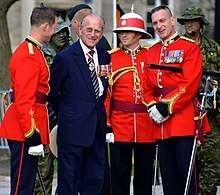
Philip has held a number of titles throughout his life. Originally holding the title and style of a prince of Greece and Denmark, Philip abandoned these royal titles prior to his marriage, and was thereafter created a British duke, among other noble titles. The Queen formally issued letters patent in 1957 making Philip a British prince.[71]
When addressing the Duke of Edinburgh, as with any male member of the royal family except the monarch, the rules of etiquette are to address him the first time as Your Royal Highness, and thereafter as Sir.[152]
Honours and honorary military appointments
The Duke of Edinburgh was appointed by King George VI to the Order of the Garter on 19 November 1947, the eve of his wedding. Since then, Philip has received 17 different appointments and decorations in the Commonwealth, and 48 from foreign states. The inhabitants of some villages on the island of Tanna, Vanuatu worship Prince Philip as a god; the islanders possess portraits of the Duke and hold feasts on his birthday.[153]
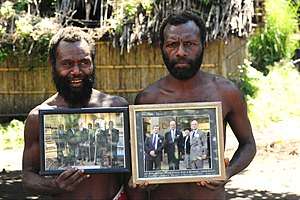
Upon his wife's accession to the throne in 1952, the Duke was appointed Admiral of the Sea Cadet Corps, Colonel-in-Chief of the British Army Cadet Force, and Air Commodore-in-Chief of the Air Training Corps.[154] The following year, he was appointed to the equivalent positions in Canada and made Admiral of the Fleet, Captain General Royal Marines, Field Marshal, and Marshal of the Royal Air Force in the United Kingdom.[155] Subsequent military appointments were made in New Zealand and Australia.[156] In 1975, he was appointed Colonel of the Grenadier Guards, a position he handed over to his son Andrew in 2017.[157] On 16 December 2015, his role as Honorary Air Commodore-in-Chief was handed over to the Duchess of Cambridge.
To celebrate his 90th birthday, the Queen appointed him Lord High Admiral,[158] as well as to the highest ranks available in all three branches of the Canadian Armed Forces.[159]
On their 70th wedding anniversary, 20 November 2017, the Queen appointed him Knight Grand Cross (GCVO) of the Royal Victorian Order, making him the first British national since his uncle Earl Mountbatten of Burma to be entitled to wear the breast stars of four orders of chivalry in the United Kingdom.[160]
Arms
 |
From 1947 to 1949: |
Issue
| Name | Birth | Marriage | Their children | Their grandchildren | |
|---|---|---|---|---|---|
| Date | Spouse | ||||
| Charles, Prince of Wales | 14 November 1948 | 29 July 1981 Divorced 28 August 1996 |
Lady Diana Spencer | Prince William, Duke of Cambridge | Prince George of Cambridge Princess Charlotte of Cambridge Prince Louis of Cambridge |
| Prince Harry, Duke of Sussex | Archie Mountbatten-Windsor | ||||
| 9 April 2005 | Camilla Parker Bowles | None | |||
| Anne, Princess Royal | 15 August 1950 | 14 November 1973 Divorced 28 April 1992 |
Mark Phillips | Peter Phillips | Savannah Phillips Isla Phillips |
| Zara Tindall | Mia Tindall Lena Tindall | ||||
| 12 December 1992 | Timothy Laurence | None | |||
| Prince Andrew, Duke of York | 19 February 1960 | 23 July 1986 Divorced 30 May 1996 |
Sarah Ferguson | Princess Beatrice, Mrs Edoardo Mapelli Mozzi | None |
| Princess Eugenie, Mrs Jack Brooksbank | None | ||||
| Prince Edward, Earl of Wessex | 10 March 1964 | 19 June 1999 | Sophie Rhys-Jones | Lady Louise Windsor | None |
| James, Viscount Severn | None | ||||
Ancestry
Both Philip and Queen Elizabeth II are great-great-grandchildren of Queen Victoria, Elizabeth by descent from Victoria's eldest son, King Edward VII, and Philip by descent from Victoria's second daughter, Princess Alice. Both are also descended from King Christian IX of Denmark.
Philip is also related to the House of Romanov through both of his parents. He is a direct descendant of Emperor Nicholas I of Russia via his paternal grandmother Grand Duchess Olga Constantinovna of Russia.[164] and his maternal grandmother, Princess Victoria of Hesse and by Rhine, was a sister of Alexandra Feodorovna (Alix of Hesse), wife of Emperor Nicholas II.
In 1993, scientists were able to confirm the identity of the remains of several members of the Romanov family, more than 70 years after their massacre in 1918, by comparing their mitochondrial DNA to living matrilineal relatives, including Philip. Philip, Alexandra, and her children are all descended from Princess Alice of the United Kingdom, the daughter of Queen Victoria, through a purely female line.[165]
| Ancestors of Prince Philip, Duke of Edinburgh[166] | |||||||||||||||||||||||||||||||||||||||||||||||||||||||||||||||||||||||||||||||||||||||||||||||||||||||||||||||||||||||||||||||||||||||||||||||||||||||||||||||||||||||||||||||||||||||||||||||||||||||||||||||||||||||||||||||||||||||||||||||||||||||||||||||||||||||||||||||||||||||||
|---|---|---|---|---|---|---|---|---|---|---|---|---|---|---|---|---|---|---|---|---|---|---|---|---|---|---|---|---|---|---|---|---|---|---|---|---|---|---|---|---|---|---|---|---|---|---|---|---|---|---|---|---|---|---|---|---|---|---|---|---|---|---|---|---|---|---|---|---|---|---|---|---|---|---|---|---|---|---|---|---|---|---|---|---|---|---|---|---|---|---|---|---|---|---|---|---|---|---|---|---|---|---|---|---|---|---|---|---|---|---|---|---|---|---|---|---|---|---|---|---|---|---|---|---|---|---|---|---|---|---|---|---|---|---|---|---|---|---|---|---|---|---|---|---|---|---|---|---|---|---|---|---|---|---|---|---|---|---|---|---|---|---|---|---|---|---|---|---|---|---|---|---|---|---|---|---|---|---|---|---|---|---|---|---|---|---|---|---|---|---|---|---|---|---|---|---|---|---|---|---|---|---|---|---|---|---|---|---|---|---|---|---|---|---|---|---|---|---|---|---|---|---|---|---|---|---|---|---|---|---|---|---|---|---|---|---|---|---|---|---|---|---|---|---|---|---|---|---|---|---|---|---|---|---|---|---|---|---|---|---|---|---|---|---|---|---|---|---|---|---|---|---|---|---|---|---|---|---|---|---|---|
| |||||||||||||||||||||||||||||||||||||||||||||||||||||||||||||||||||||||||||||||||||||||||||||||||||||||||||||||||||||||||||||||||||||||||||||||||||||||||||||||||||||||||||||||||||||||||||||||||||||||||||||||||||||||||||||||||||||||||||||||||||||||||||||||||||||||||||||||||||||||||
Notes
- He was born on 10 June 1921 according to the Gregorian calendar. Until 1 March 1923, Greece used the Julian calendar, in which the date is 28 May 1921.
- The Danish Act of Succession 1953 removed the succession rights of his branch of the family in Denmark,[4] while Philip had renounced these titles prior to his marriage to Princess Elizabeth in November 1947.
- The amount was set by the Civil List (Increase of Financial Provision) Order 1990. It was initially set at £40,000 in the Civil List Act 1952, raised to £65,000 by the Civil List Act 1972, and raised to £165,000 by the Civil List (Increase of Financial Provision) Order 1984.
References
- Canadian Heritage Archived 17 March 2012 at the Wayback Machine; Daily Telegraph; Sky News; Website of the Royal Family, all retrieved 10 June 2011
- "Do your DofE – The Duke of Edinburgh's Award". dofe.org. Archived from the original on 29 January 2019. Retrieved 29 January 2019.
- Brandreth, p. 56
- Tågholt, Knud (1963). Det glücksburgske kongehus, fra Christian IX til prinsesse Margrethe: Den danske kongeslægt gennem hundrede år, 1863-1963. Aros. p. 6.
- Brandreth, pp. 58–59
- "News in Brief: Prince Andrew's Departure". The Times: 12. 5 December 1922.
- Alexandra, pp. 35–37; Heald, p. 31; Vickers, pp. 176–178
- Rocco, Fiammetta (13 December 1992). "A strange life: Profile of Prince Philip". The Independent. London. Retrieved 22 May 2010.
- Eade, Philip (5 May 2017). "The romances of young Prince Philip". The Daily Telegraph. Retrieved 10 August 2018.
- Boothroyd, Basil (1971). Prince Philip: An Informal Biography (First American ed.). New York: McCall Publishing Company. ISBN 0841501165.
- Alexandra, p. 42; Heald, p. 34. Fellow pupils at the school included Princess Anne of Bourbon-Parma, who later married King Michael of Romania.
- Heald, pp. 35–39
- Brandreth, p. 66; Vickers, p. 205
- Eade, p. 104
- Brandreth, p. 67
- Prince Philip quoted in Brandreth, p. 72
- Brandreth, p. 72; Heald, p. 42
- Brandreth, p. 69; Vickers, p. 273
- Brandreth, pp. 77, 136
- Eade, pp. 129–130; Vickers, pp. 284–285, 433.
- "Naval career". Official website of the British Monarchy. Archived from the original on 29 May 2010. Retrieved 7 May 2010.
- Vickers, pp. 293–295.
- Eade, pp. 132–133.
- Heald, p. 60.
- "No. 35455". The London Gazette. 13 February 1942. p. 715.
- Brandreth, p. 154; Heald, p. 66.
- Smith, David (28 December 2003). "Prince Philip's war heroics come to light after 60 years". The Guardian. London. Retrieved 12 October 2008.
- "No. 35664". The London Gazette. 11 August 1942. p. 3510.
- Brandreth, pp. 155–163; Heald, pp. 66–67.
- "HMS Whelp, destroyer". Naval-history.net. Retrieved 12 October 2008.
- Brandreth, p. 176.
- Queen Alexandra of Yugoslavia quoted in Heald, p. 57
- Brandreth, pp. 132–136, 166–168
- Brandreth, p. 183
- Heald, p. 77
- The Times, 10 July 1947, p. 4
- Boothroyd, Basil (1971). Prince Philip: An Informal Biography. McCall. pp. 45–47. ISBN 0841501165.
- "Elizabeth's Fiance Now an Anglican" The New York Times, 4 October 1947
- "No. 38128". The London Gazette. 21 November 1947. pp. 5495–5496.
- Heald, p. 86
- "Queen celebrates diamond wedding". BBC News. 19 November 2007. Retrieved 10 February 2017.
- Rayner, Gordon (19 November 2012). "Queen and Duke of Edinburgh celebrate 65th wedding anniversary". The Daily Telegraph. Retrieved 10 February 2017.
- "HRH The Duke of Edinburgh (Lords Sitting of 21 July 1948)". UK Parliament. Archived from the original on 20 August 2018. Retrieved 31 October 2018.
- "Earl Mountbatten of Burma (Lords Sitting of 21 July 1948)". UK Parliament. Archived from the original on 20 August 2018. Retrieved 31 October 2018.
- Alexandra, pp. 100, 105–106
- Heald, p. 94
- Heald, p. 95
- "No. 38994". The London Gazette (Supplement). 15 August 1950. p. 4152.
- "No. 39597". The London Gazette. 15 July 1952. p. 3821.
- "The Duke of Edinburgh > Military involvement". Official website of the British Monarchy. Archived from the original on 28 May 2010. Retrieved 7 May 2010.
- Heald, p. 97
- Brandreth, pp. 245–247
- Soames, Emma (1 June 2012). "Emma Soames: As Churchills we're proud to do our duty". Retrieved 12 March 2019.
- Brandreth, pp. 253–254
- "Supplement to The London Gazette of Friday, 5th February 1960". The London Gazette. 8 February 1960.
- Travis, Alan (18 February 1999). "Queen feared 'slur' on family", The Guardian. Retrieved 17 April 2014
- British-Japanese Parliamentary Group. Tour of the Palace of Westminster. Retrieved 2012/5/2.
- "Love and Majesty". Vanity Fair. January 2012.
- "Prince Philip: The Man At The Queen's Side". ITV. 5 June 2012.
- "Royal Public Finances" (PDF). Archived from the original (PDF) on 24 February 2014. Retrieved 7 August 2014.
- "Living off the State, A critical guide to UK Royal Finance", Jon Temple, 2nd edition 2012
- "Sovereign grant Act 2011: Tax". www.gov.uk. Retrieved 7 August 2014.
- Brandreth, p. 259
- Brandreth, p. 263
- Brandreth, p. 270
- Brandreth, p. 278
- Nikkhah, Roya. "Prince Philip: The Duke you don't know". The Telegraph (UK). Retrieved 12 December 2017.
- Quoted in Brandreth, p. 287
- Brandreth, pp. 287, 289
- Brandreth, p. 288
- "No. 41009". The London Gazette. 22 February 1957. p. 1209.
- Bousfield, Arthur; Toffoli, Gary (2002). Fifty Years the Queen. Toronto: Dundurn Press. p. 12. ISBN 1-55002-360-8.
- "Prince Philip (HRH The Duke of Edinburgh)". The Canadian Encyclopedia. Historica Canada. Archived from the original on 9 June 2017. Retrieved 23 June 2017.
- Brandreth, p. 50
- "Duke of Edinburgh attended boxing match as first of 22,000 official duties". Metro News. Archived from the original on 24 January 2019. Retrieved 23 January 2019.
- "Prince William succeeds the Duke of Edinburgh as he gives up royal role". Daily Express. 9 April 2013. Retrieved 7 December 2016.
- "Philip, Duke of Edinburgh, Talks Love of and Involvement in Combined Driving". US Equestrian. US Equestrian Communications Department. Archived from the original on 12 December 2017. Retrieved 12 December 2017.CS1 maint: BOT: original-url status unknown (link)
- "The Duke of Edinburgh: Activities and interests". Official website of the British Monarchy. Archived from the original on 6 November 2011. Retrieved 19 October 2011.
- "Our Chief Executive thanks Prince Philip for his commitment as Patron". News Archive. British Heart Foundation. Archived from the original on 30 December 2017. Retrieved 30 December 2017.CS1 maint: BOT: original-url status unknown (link)
- "St Edmund's College – University of Cambridge". www.st-edmunds.cam.ac.uk. Archived from the original on 10 September 2018. Retrieved 10 September 2018.
- Brandreth, p. 344; Lacey, p. 276
- Brandreth, p. 346; Lacey, pp. 277–278
- Brandreth, pp. 348–349
- Brandreth, pp. 349–351
- Brandreth, pp. 351–353
- Brandreth, p. 358
- Brandreth, p. 359
- "Duke 'did not order Diana death'". BBC News. 31 March 2008. Retrieved 22 May 2010.
- "Prince Philip reaches milestone". BBC News. 18 April 2009. Retrieved 7 June 2013.
- "Prince Philip, 97, becomes third oldest royal (and oldest ever male) in British history - but who is number one?". ITV News. 19 April 2019. Retrieved 19 April 2019.
- "Duke of Edinburgh is in hospital". BBC News. 4 April 2008. Retrieved 12 October 2008.
- "Prince discharged from hospital". BBC News. 6 April 2008. Retrieved 12 October 2008.
- "Statement From Buckingham Palace Following the Evening Standard's Story Entitled 'Prince Philip Defies Cancer Scare'". Buckingham Palace. 6 August 2008. Archived from the original on 2 December 2010. Retrieved 20 April 2010.
- "British Paper Retracts Story Claiming Prince Philip Has Prostate Cancer". Fox News. 8 August 2008. Archived from the original on 10 January 2014. Retrieved 1 January 2019.
- "Paper apologises for Prince Philip story". The Sydney Morning Herald. 8 August 2008.
- "Prince Philip Turns 90 and Vows to 'Slow Down'". BBC News. 10 June 2011. Retrieved 11 June 2011.
- "New title for Duke of Edinburgh as he turns 90". BBC News. 10 June 2011. Retrieved 10 June 2011.
- Peter Hunt (24 December 2011). "Prince Philip has heart procedure at Papworth Hospital". BBC News. Retrieved 24 December 2011.
- "Duke of Edinburgh leaves hospital". BBC News. 27 December 2011. Retrieved 27 December 2011.
- "Duke of Edinburgh hospitalised". ITN. 4 June 2012. Retrieved 5 June 2012.
- "Prince Philip in hospital and to miss Diamond Jubilee concert". BBC News. 4 June 2012. Retrieved 4 June 2012.
- "Britain's Prince Philip released from hospital in time for his birthday". CNN. 9 June 2012.
- "Prince Philip leaves Aberdeen hospital after five nights". BBC News. 20 August 2012.
- "Prince Philip leaves hospital, will recuperate at Windsor Castle". CNN. 17 June 2013. Retrieved 17 June 2013.
- "Duke of Edinburgh has 'minor procedure' on hand". BBC News. 21 May 2014. Retrieved 7 August 2014.
- Furness, Hannah (21 June 2017). "Prince Philip admitted to hospital with infection and misses State Opening of Parliament". The Daily Telegraph. Retrieved 12 November 2017.
- Davies, Caroline (21 June 2017). "Prince Philip to spend second night in hospital". The Guardian. Retrieved 12 November 2017.
- Mackintosh, Eliza (22 June 2017). "UK's Prince Philip Discharged from Hospital after Treatment for Infection". CNN. Retrieved 12 November 2017.
- "Prince Philip carries out final royal engagement before retirement". Sky News. 2 August 2017.
- "Prince Philip carries out final official engagement". BBC News. 2 August 2017.
- "Queen and Prince Philip portraits released to mark 70th anniversary". The Guardian. 20 November 2017. Retrieved 20 November 2017.
- "Duke of Edinburgh leaves hospital". BBC News. 13 April 2018. Retrieved 13 April 2018.
- "Royal Wedding 2018". BBC News. Retrieved 23 May 2018.
- "Princess Eugenie wedding in pictures: Splendid hats and gusts of wind". BBC News. 12 October 2018.
- Tominey, Camilla (9 October 2018). "Duke of Edinburgh 'will decide at last moment' whether he attends royal wedding of Princess Eugenie". The Telegraph. Retrieved 11 November 2018.
- Hannah Furness (18 January 2019). "Prince Philip crash: Duke 'asked if everyone else was alright' after car 'tumbled' across road leaving him bleeding". The Telegraph. Retrieved 18 January 2019.
- Haroon Siddique (20 January 2019). "Prince Philip has not said sorry for car crash, injured woman claims". The Guardian. Retrieved 20 January 2019.
- Caroline Davies (18 January 2018). "Prince Philip undergoes hospital checks after car crash". The Guardian. Retrieved 18 January 2019.
- Victoria Ward (27 January 2019). "Prince Philip sends personal apology to victims of Sandringham car crash". The Telegraph. Retrieved 9 February 2019.
- Lin Jenkins (9 February 2019). "Prince Philip gives up driving licence three weeks after car crash". The Guardian. Retrieved 9 February 2019.
- "Prince Philip, 97, gives up driving licence". BBC. 9 February 2019. Retrieved 10 February 2019.
- Owen Bowcott (14 February 2019). "Prince Philip will not be prosecuted over car crash, says CPS". The Guardian. Retrieved 14 February 2019.
- "Prince Philip 'spotted behind wheel for first time since giving up licence'". Irish Examiner. 18 April 2019. Archived from the original on 18 April 2019. Retrieved 19 April 2019.
- "Prince Philip leaves hospital to spend Christmas with the Queen". The Independent. 24 December 2019. Retrieved 26 May 2020.
- "Prince Philip taken to hospital as a 'precautionary measure'". BBC News. 20 December 2019. Retrieved 20 December 2019.
- "Prince Philip: Photo with Queen to mark Duke of Edinburgh's 99th birthday". BBC News. 9 June 2020. Retrieved 9 June 2020.
- Heald, pp. 212–214
- Heald, pp. 148–149
- Monarchy, British. "The Royal Air Force". Official website of the British Monarchy. Archived from the original on 17 June 2013. Retrieved 6 May 2013.
- Sparkes, Matthew (22 April 2014). "Royal couples' grandparents' jet-age meeting". Daily Telegraph. Retrieved 7 May 2014.
- Tominey, Camilla (14 February 2016). "Truth behind Prince George's love of aviation". Daily Express. UK. Retrieved 19 February 2015.
It (the photograph) shows the Duchess of Cambridge's grandfather, Captain Peter Middleton, with Prince Philip in 1962...
- Lacey, p. 368
- Heald, p. 253
- Goodwin, Christopher (18 January 2009). "I'm tickled to death. I never thought I'd see such a thing". The Guardian. London.
- "Prince Philip at 90 on a lifetime of speaking his mind". BBC News. Retrieved 22 April 2016.
- "Caught on tape: Infamous gaffes". BBC News. 19 September 2006. Retrieved 12 October 2008.
- Blair, Tim (23 May 2008). "Prince Philip right to have a dig at Durie". News.com.au. Archived from the original on 8 January 2009. Retrieved 12 October 2008.
- "AM – Prince Philip reminded of blunders on his 85th birthday". Australian Broadcasting Corporation. Retrieved 12 October 2008.
- Naysmith, Stephen (23 April 2000). "The Secret Life of Prince Philip". Sunday Herald. Archived from the original on 6 December 2008. Retrieved 12 October 2008.
- Duggan, Paul. "Prince Philip Has a Mouthful Of a Title. And, Often, His Foot". The Washington Post. Retrieved 12 October 2008.
- Dolby, Karen (2015). The Wicked Wit of Queen Elizabeth II. London: Michael O'Mara Books. p. 44.
- Prince Philip quoted in Brandreth, p. 7
- Starkey, speaking on BBC News Radio Four, 10 June 2011
- Brandreth, p. 46
- Letter of 4 June 1999 quoted in Brandreth, p. 46
- Leach, By Ben. "Duke of Edinburgh gaffes by mocking blind boy". The Telegraph. Retrieved 22 April 2016.
- Heald, pp. 244–245; Lacey, p. 303
- Lacey, p. 304; see also Heald, p. 245 for a Hong Kong version of the "round-eyed" joke.
- Heald, p. 246; Lacey, p. 304
- "The Crown: Tobias Menzies cast as new Prince Philip". BBC. 29 March 2018. Retrieved 10 April 2018.
- Cassidy, Suzanne (25 December 1993). "The British Novelist Who Turned A Class System Upside Down". The New York Times. Retrieved 16 September 2015.
- "Royalty – Debrett's Guide to British Behaviour". 12 November 2010. Archived from the original on 12 November 2010. Retrieved 23 May 2018.
- Squires, Nick (10 June 2007). "Is Prince Philip an island god?". London, UK: BBC News. Retrieved 12 October 2008.
- Heald, p. 111
- Heald, pp. 264–267
- Brandreth, pp. 407–408; Heald, pp. 264–267
- "The Duke of York is appointed Colonel of the Grenadier Guards". Royal Household. 1 December 2017.
- "The Duke of Edinburgh appointed Lord High Admiral". royal.uk. 10 June 2011. Retrieved 4 June 2016.
- Office of the Prime Minister of Canada (10 June 2011). "PM announces the appointment of His Royal Highness the Duke of Edinburgh to the highest ranks of the Canadian Armed Forces". Queen's Printer for Canada. Archived from the original on 16 November 2016. Retrieved 10 June 2011.
- Furness, Hannah (20 November 2017). "Queen grants new honour to Prince Philip for 70th wedding anniversary". The Telegraph. Retrieved 22 November 2017.
- Boutell's Heraldry. (1973) ISBN 0-7232-1708-4.
- Pinches, J. H. & R. V., The Royal Heraldry of England, 1974, Heraldry Today.
- "Duke of Edinburgh". 13 January 2009. Archived from the original on 13 January 2009. Retrieved 23 May 2018.
- Montgomery-Massingberd, Hugh (ed.) (1977). Burke's Royal Families of the World, 1st edition. London: Burke's Peerage. pp. 469–474. ISBN 0-85011-023-8.CS1 maint: extra text: authors list (link) CS1 maint: ref=harv (link)
- Gill, Peter; Ivanov, Pavel L.; Kimpton, Colin; Piercy, Romelle; Benson, Nicola; Tully, Gillian; Evett, Ian; Hagelberg, Erika; Sullivan, Kevin (February 1994). "Identification of the remains of the Romanov family by DNA analysis". Nature Genetics. 6 (2): 130–135. doi:10.1038/ng0294-130. PMID 8162066.
- Louda, Jiří; Maclagan, Michael (1999) [1981]. Lines of Succession: Heraldry of the Royal Families of Europe (2nd ed.). London: Little, Brown. p. 34. ISBN 978-0-316-84820-6.
Bibliography
- Alexandra of Yugoslavia (1959). Prince Philip: A Family Portrait. London: Hodder and Stoughton.
- Boothroyd, Basil (1971). Prince Philip: An Informal Biography. New York: McCall. ISBN 0-841-50116-5
- Brandreth, Gyles (2004). Philip and Elizabeth: Portrait of a Marriage. London: Century. ISBN 0-7126-6103-4
- Eade, Philip (2011). Prince Philip: The Turbulent Early Life of the Man Who Married Queen Elizabeth II. New York: St. Martin's Griffin. ISBN 978-1-250-01363-7
- Heald, Tim (1991). The Duke: A Portrait of Prince Philip. London: Hodder and Stoughton. ISBN 0-340-54607-7
- Lacey, Robert (2002). Royal: Her Majesty Queen Elizabeth II. London: Little, Brown. ISBN 0-316-85940-0
- Vickers, Hugo (2000). Alice, Princess Andrew of Greece. London: Hamish Hamilton. ISBN 0-241-13686-5
External links
- The Duke of Edinburgh at the Royal Family website
- Philip, Duke of Edinburgh at the Encyclopædia Britannica
- Duke of Edinburgh's profile on BBC
- The Duke of Edinburgh's Award
- Prince Philip, Duke of Edinburgh on IMDb
- In the Words of Prince Philip – slideshow by Life
- Newspaper clippings about Prince Philip, Duke of Edinburgh in the 20th Century Press Archives of the ZBW
Prince Philip, Duke of Edinburgh House of Schleswig-Holstein-Sonderburg-Glücksburg Born: 10 June 1921 | ||
| British royalty | ||
|---|---|---|
| Preceded by Elizabeth Bowes-Lyon as queen consort |
Consort of the British monarch 6 February 1952 – present |
Incumbent |
| Peerage of the United Kingdom | ||
| New creation | Duke of Edinburgh 1947–present |
Incumbent Heir: The Prince of Wales |
| Academic offices | ||
| Preceded by The Marquess of Linlithgow |
Chancellor of the University of Edinburgh 1953–2010 |
Succeeded by The Princess Royal |
| New institution | Chancellor of the University of Salford 1967–1991 |
Succeeded by The Duchess of York |
| Preceded by The Lord Adrian |
Chancellor of the University of Cambridge 1976–2011 |
Succeeded by The Lord Sainsbury of Turville |
| Honorary titles | ||
| Preceded by Queen Mary |
Grand Master of the Order of the British Empire 24 March 1953 – present |
Incumbent |
| Preceded by King George VI |
Air Commodore-in-Chief of the Air Training Corps 1953–2015 |
Succeeded by The Duchess of Cambridge As Air Commandant |
| Military offices | ||
| Preceded by Queen Elizabeth II |
Lord High Admiral 10 June 2011 – present |
Incumbent |
| Lines of succession | ||
| Preceded by India Hicks |
Line of succession to the British throne (descended from Alice, daughter of Queen Victoria) |
Succeeded by The Margrave of Baden |
| Order of precedence | ||
| Preceded by The Sovereign |
Orders of precedence in the United Kingdom | Followed by The Prince of Wales, Duke of Rothesay |
.svg.png)
